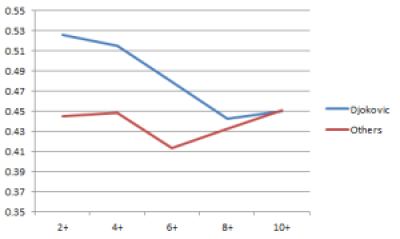Italian translation at settesei.it
In yesterday’s quarterfinal between Simona Halep and Victoria Azarenka, a highlight early in the third set was a 25-shot rally that Vika finished off with a forehand winner. It was the longest point of the match, and moved her within a point of holding serve to open the set.
As very long rallies often do, the point seemed like it might represent a momentum shift. Instead, Halep sent the game back to deuce after a 10-stroke rally on the next point. If there was any momentum conferred by these two points, it disappeared as quickly as it arose. It took eight more points before Azarenka finally sealed the hold of serve.
Does a long rally tell us anything at all? Does it have predictive value for the next point, or even the entire game, or is it just highlight-reel fodder that is forgotten as soon as the umpire announces the score?
To answer those questions, I delved into the shot-by-shot data of the Match Charting Project, which now contains point-by-point accounts of nearly 1,100 matches. I identified the longest 1% of points–17 shots or longer for women, 18 shots for men–and analyzed what happened afterwards, looking for both fatigue and momentum effects.
The next point
There’s one clear effect of a long rally: The next point will be shorter than average. The 10-shot rally contested by Vika and Simona yesterday was an outlier: Women average 4.45 shots on the point after a long rally, while the overall average (controlled for server and first or second serve) is 4.85. Men average 4.03 shots on the following point, compared to an average of 4.64.
For women, fatigue is also a factor for the server. Following a long rally, women land only 61.3% of first serves, compared to an average of 64.6%. Men don’t exhibit the same fatigue effect; the equivalent numbers are 62.3% and 62.2%.
There’s more evidence of an immediate fatigue factor for women, as well. The players who win those long rallies are slightly better than their opponents, winning 50.7% of points on average. Immediately after a long rally, however, players win only 49% of points. It’s not obvious to me why this should be the case. Perhaps the player who won the long rally worked a bit harder than her opponent, maybe putting all of her remaining effort into a groundstroke winner, or finishing the point with a couple of athletic shots at the net.
In any case, there’s no equivalent effect for men. After winning a long rally, players win 51.1% of their next points, compared to an expected 50.8%. That’s either a very small momentum effect or, more likely, a bit of statistical noise.
Both men and women double fault more often than usual after a long rally, though the effect is much greater for women. Immediately following these points, women double fault 4.7% of the time, compared to an average of 3.3%. Men double fault 4.5% of the time after a long rally, compared to an expected rate of 4.2%.
Longer-term momentum
Beyond a slightly effect on the characteristics of the next point, does a long rally influence the outcome of the game? The evidence suggests that it doesn’t.
For each long rally, I identified whether the winner of the rally went on to win the game, as Vika did yesterday. I also combined the score after the long rally with the average rate of points won on the appropriate player’s serve to calculate the odds that, from such a score, the player who won the rally would go on to win the game. To use yesterday’s example, when Azarenka held game point at AD-40, her chances of winning the game were 77.6%.
For both men and women, there is no significant effect. Women who won long rallies went on to win 66.2% of those games, while they would have been expected to win 65.7%. Men won 64.4% of those games, compared to an expected rate of 64.1%.
With a much larger dataset, these findings might indicate a very slight momentum effect. But limited to under 1,000 long-rally points for each gender, the differences represent only a few games that went the way of the player who won the long point.
For now, we’ll have to conclude that the aftereffects of a long rally have a very short lifespan: barely one point for women, perhaps not even that long for men. These points may well have a greater effect on fans than they do on the players themselves.
